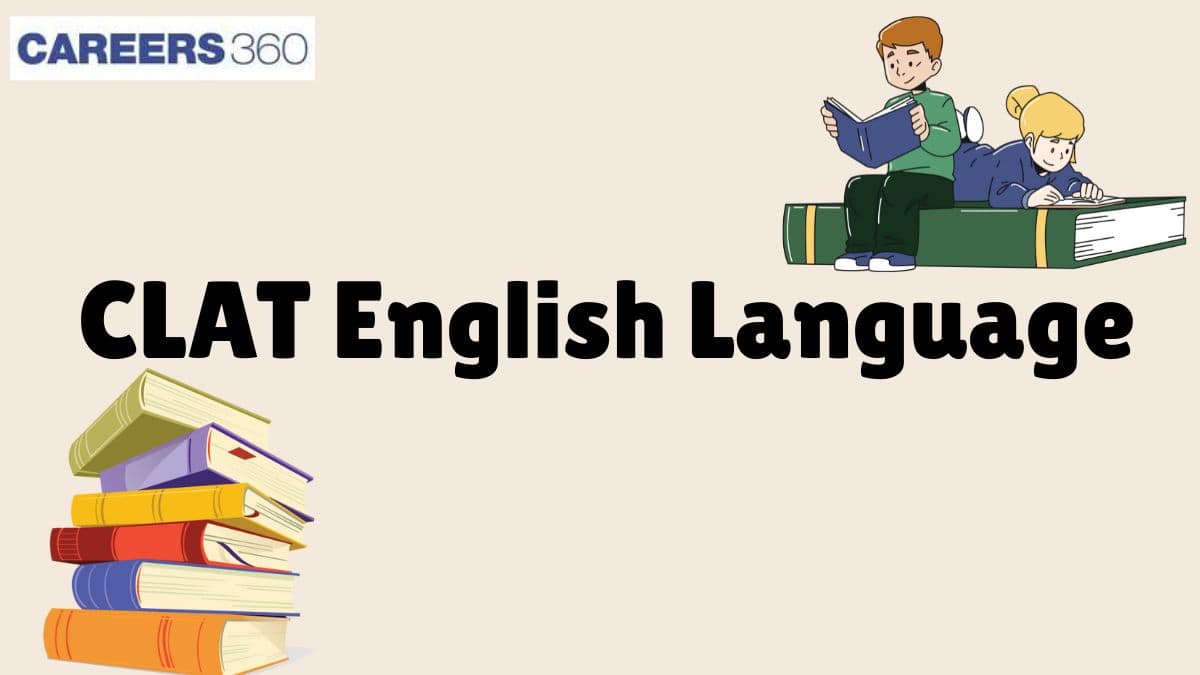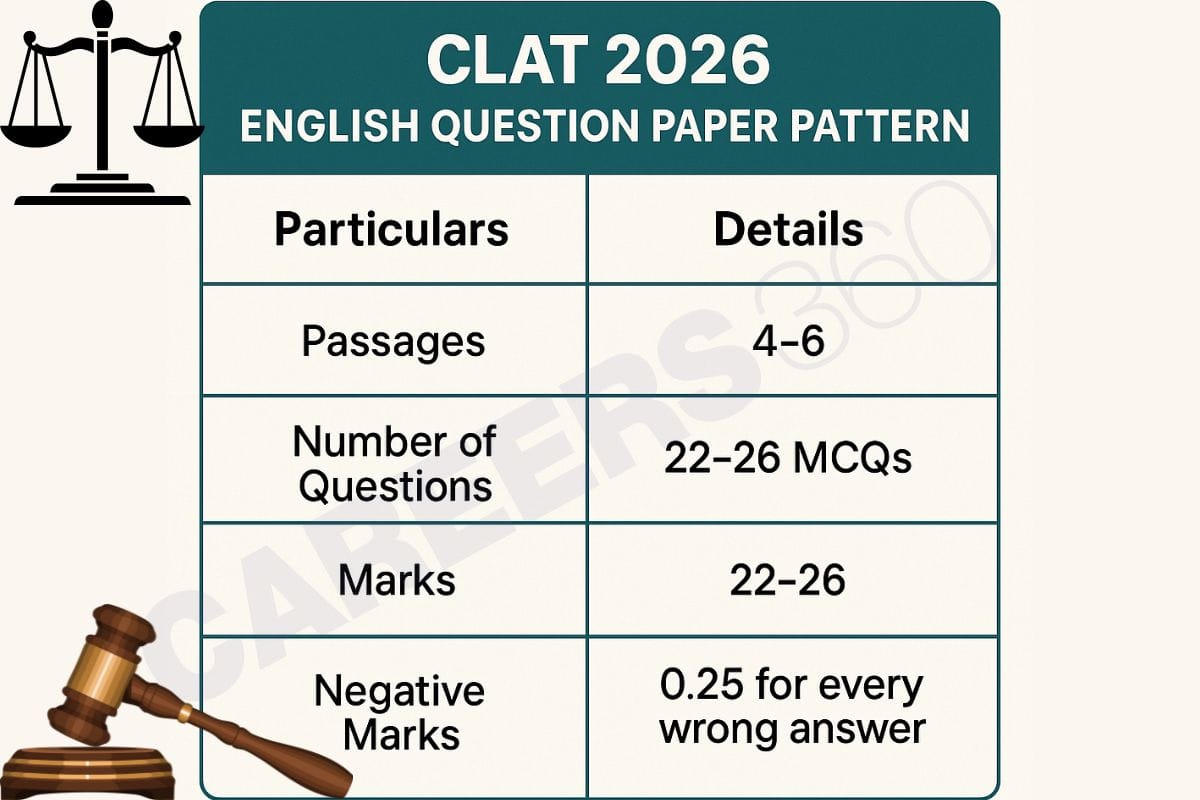Amity University-Noida Law Admissions 2026
Among top 100 Universities Globally in the Times Higher Education (THE) Interdisciplinary Science Rankings 2026
The Common Law Admission Test (CLAT) is one of the lengthiest law entrance exams and is a test of one's language and reading skills. Therefore, preparing for CLAT English is prominent in any aspiring candidate's exam preparation regime. The English language section of CLAT 2026 focuses on evaluating the candidate’s reading and comprehension ability and forming critical insights about a given passage. The passages in the CLAT 2026 English Language section will be drawn from contemporary or historically significant fiction and non-fiction works, written at a level that a Class 12 student can read within 5 to 7 minutes. The questions in the CLAT English section are from a 12th-standard level.
In the table below are the counselling dates of CLAT 2026.
| Event | Date |
| Release of the first allotment list | January 7, 2026 (10:00 AM) |
| Payment of the seat confirmation fee | January 7 - January 15, 2026 |
| Deadline for document upload | January 15, 2026 (1:00 PM) |
| Release of the second allotment list | January 22, 2026 |

The candidates should have a clear idea about the CLAT exam pattern, and should refer to best CLAT English books. Read the full article for relevant details about the CLAT 2026 English section that will help any candidate perform well in the exam.
The CLAT 2026 English language syllabus seeks to test the reading and comprehension ability of the candidate and form insights about the passages. The reading and comprehension preparation for the English section will also help the candidates in other sections of the exam, as the Common Law Admission Test is a very reading-intensive paper.
Preparation for any exam should start with understanding what the exam constitutes. The CLAT 2026 is no different. As per the revised syllabus of CLAT issued by the consortium from 2024 onwards, the CLAT 2026 English questions number between 22-26 in a paper that consists of 120 questions. One can notice that the English for CLAT forms roughly 20% of the overall CLAT syllabus.
Among top 100 Universities Globally in the Times Higher Education (THE) Interdisciplinary Science Rankings 2026
Ranked #18 amongst Institutions in India by NIRF | Ranked #1 in India for Academic Reputation by QS Rankings | 16 LPA Highest CTC
| Particulars | Details |
|---|---|
| Passages | 4-6 |
| Number of Questions | 22-26 MCQs |
| Marks | 22-26 |
| Negative Marks | 0.25 for every wrong answer |

In the CLAT exam English syllabus, the candidate will come across several sets of passages consisting of around 450 words. The reading difficulty of these passages is of 12th grade level, equivalent to the minimum qualification prescribed for candidates in the CLAT eligibility criteria. The passages centre around recent or historically important fiction and nonfiction pieces of literature. The candidate is expected to take no more than 5-7 minutes to read each passage. Based on the passage, the candidate has to answer follow-up CLAT English questions that test their comprehension and linguistic ability.
Reading and understanding the passage's primary idea as well as any arguments and points of view presented therein
Making deductions and conclusions from the passage
Summarising the text in the passage
Comparing and contrasting the opinions expressed in the passage
Recognising the meaning of the different terms and expressions used in the passage.
Here are some important topics from CLAT English section
Also Read: CLAT English Preparation Tips
Once the syllabus is properly studied, the next step in CLAT exam preparation is to familiarise oneself with the type of questions one would come across in the English language for CLAT 2026. Going through the CLAT sample papers is an important part of the preparation. Practising with the mock tests can also improve one’s performance in the actual test.
The Consortium of National Law Universities (CNLU), which is the body responsible for conducting the exam, will release CLAT 2026 sample papers in the run-up to the CLAT 2026 exam, to be held on December 7, 2025. The papers can be downloaded from the official website of the CNLU - consortiumofnlus.ac.in
Besides solving the sample papers, candidates must also go through the previous year’s CLAT Question Papers to be exam-ready. It will help in understanding what to expect during the exam. Narrowing down the ambit will enhance focus during one’s preparation.
Candidates can focus specifically on the CLAT English section by solving CLAT English sample papers, which will improve their chances of success in this section.
You may also check
From a very early age, I knew that when I grew up, I should be a writer. I had the lonely child’s habit of making up stories and holding conversations with imaginary persons, and I think from the very start my literary ambitions were mixed up with the feeling of being isolated and undervalued. I knew that I had a facility with words and a power of facing unpleasant facts, and I felt that this created a sort of private world in which I could get my own back for my failure in everyday life. I wanted to write enormous naturalistic novels with unhappy endings, full of detailed descriptions and arresting similes, and also full of purple passages in which words were used partly for the sake of their sound. I give all this background information because I do not think one can assess a writer’s motives without knowing something of his early development.
His subject-matter will be determined by the age he lives in – at least this is true in tumultuous, revolutionary ages like our own – but before he ever begins to write he will have acquired an emotional attitude from which he will never completely escape. It is his job to discipline his temperament, but if he escapes from his early influences altogether, he will have killed his impulse to write. I think there are four great motives for writing, at any rate for writing prose. They are: (i) Sheer egoism: Desire to seem clever, to be talked about, to be remembered after death, to get your own back on grown-ups who snubbed you in childhood; (ii) Aesthetic enthusiasm: Desire to share an experience which one feels is valuable and ought not to be missed (iii) Historical impulse: Desire to see things as they are, to find out true facts and store them up for the use of posterity (iv) Political purpose: Desire to push the world in a certain direction, to alter other people’s idea of the kind of society that they should strive after. [Extracted with edits from George Orwell’s “Why I Write”]
1. For the author, aesthetic enthusiasm is an important motive for writing because it
(A) shapes the thoughts
(B) creates an artistic piece
(C) becomes invaluable
(D) non-utilitarian
2. The author strongly advocates the writers to:
(A) avoid any egoistic impression in their work
(B) be apolitical in their approach
(C) be contemporary in their treatment of their work
(D) None of the above
3. Which of the following is a synonym for the word “tumultuous”?
(A) Chaotic
(B) Turbulent
(C) Disorderly
(D) All of the above
4. George Orwell’s loneliness during childhood led to
(A) estrangement with his father
(B) unhappy days
(C) making up stories
(D) unpleasant incidents
5. Why does Orwell give background information?
(A) He had the lonely child’s habits
(B) It is essential to know about the motives of writers
(C) Because of his historic impulse
(D) Due to the aesthetic enthusiasm
6. If writer escapes from early impulses, he will
(A) lose his urge to write
(B) be unable to imagine creatively
(C) be able to converse with imaginary characters
(D) be able to influence others
You may also check the top career options after studying Law:
One should refer to good books for CLAT preparation to ace the exams. The English section is no different. There are several good books for CLAT 2026 English section available in the market. Some of them are given in the table below
| Objective General English | R.S Aggarwal |
| Word Power Made Easy | Norman Lewis |
| Essential English for Competitive Examinations | Rashmi Singh |
| CLAT Guide | Tata McGraw Hill |
| The Pearons Guide to CLAT | Pearson's |
You may also read
Frequently Asked Questions (FAQs)
The syllabus of English language includes grammar, sentence structure, syntax and errors, vocabulary and answering direct questions from the passage.
The english in CLAT is of 12th standard.
The English section of the CLAT has 22-26 questions.
This section requires the candidate to read and comprehend passages and then answer ensuing questions.
The Consortium of National Law Universities will release three CLAT sample papers before the actual exam that can be downloaded from their website.
Word Power Made Easy by Norman Lewis and Objective General English by RS Aggarwal are some of the best books for CLAT English.
On Question asked by student community
Since you scored 8000 AIR in CLAT, getting into top NLUs may not be possible, so it is a good idea to look for affordable and good law colleges.
State government law colleges are usually low in fees, and have decent reputation. Some options include Government Law College, Mumbai, Faculty
Yes you can get addmission into UPES dehradun with the clat rank of 8037
Through the below college predictor you will get the list of best collges based on your rank:
CLAT College Predictor 2026 (Free) - https://law.careers360.com/clat-college-predictor
Hope it helps
With 67 marks in and SC rank 415 in CLAT, you have a very good chance of getting admission in CNLU Patna BA LLB. The SC category cut-off at Patna NLU are usually much lower than the general category, so your rank is well within the likely range. Final admission
HELLO,
For CLAT 2026 counselling , the only official registration window announced by the Consortium of NLUs was from 17 Dec 2025 to 27 Dec 2025 that was last date to register and pay the fee. There are no additional or alternate registration dates released for 2026 beyond this window.
With an AIR of 34724 and OBC category rank of 7153, chances of getting a seat in DSNLU Visakhapatnam are low in early rounds. However, since you are already invited for counselling, there may be some chance in later rounds depending on seat vacancy and cut-off movement. You should participate
Among top 100 Universities Globally in the Times Higher Education (THE) Interdisciplinary Science Rankings 2026
Excellent curriculum; an impressive range of electives, besides core law courses. Up to 100% merit scholarship on a first-come, first-served basis
Ranked #18 amongst Institutions in India by NIRF | Ranked #1 in India for Academic Reputation by QS Rankings | 16 LPA Highest CTC
AICTE & UGC Approved | NAAC A+ Accredited
NAAC A+ Accredited | Among top 2% Universities Globally (QS World University Rankings 2026)
NAAC A++ Approved | Curriculum Aligned with BCI & UGC